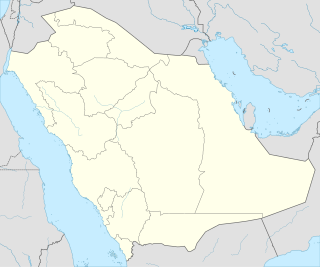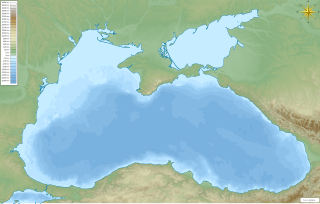
Ghawar is an oil field located in Al-Ahsa Governorate, Eastern Province, Saudi Arabia. Measuring 280 by 30 km, it is by far the largest conventional oil field in the world, and accounts for roughly a third of the cumulative oil production of Saudi Arabia as of 2018.

The South Pars/North Dome field is a natural-gas condensate field located in the Persian Gulf. It is by far the world's largest natural gas field, with ownership of the field shared between Iran and Qatar. According to the International Energy Agency (IEA), the field holds an estimated 1,800 trillion cubic feet of in-situ natural gas and some 50 billion barrels of natural gas condensates. On the list of natural gas fields it has almost as much recoverable reserves than all the other fields combined. It has significant geostrategic influence.

The petroleum industry of Ghana is regulated by the state-owned Ghana National Petroleum Corporation (GNPC) and administered by the state-owned Ghana Oil Company (GOIL).
As of 2005, Azerbaijan produced a range of metals and industrial minerals, including aluminum, lead, iron, and zinc.
Energy in Saudi Arabia involves petroleum and natural gas production, consumption, and exports, and electricity production. Saudi Arabia is the world's leading oil producer and exporter. Saudi Arabia's economy is petroleum-based; oil accounts for 90% of the country's exports and nearly 75% of government revenue. The oil industry produces about 45% of Saudi Arabia's gross domestic product, against 40% from the private sector. Saudi Arabia has per capita GDP of $20,700. The economy is still very dependent on oil despite diversification, in particular in the petrochemical sector.
Energy in Gabon is an industry with plenty of potential.
Krishna Godavari Basin is a peri-cratonic passive margin basin in India. It is spread across more than 50,000 square kilometres in the Krishna River and Godavari River basins in Andhra Pradesh. The site is known for the D-6 block where Reliance Industries discovered the biggest natural gas reserves in India in 2003

Vale is an offshore gas field in the North Sea located 16 kilometres (9.9 mi) north of the Heimdal gas field. The depth of the water in the field area is 115 metres (377 ft). Vale is considered a satellite to Heimdal field and is connected to it by a pipeline. Estimated reserves at Vale stand at 2.5 billion cubic metres of natural gas and 21 million barrels (3,300,000 m3) of gas condensate. Vale gas field is expected to produce 1.6 million cubic metres per day of natural gas and 2,600 barrels per day (410 m3/d) of condensate.
The Lebăda Vest oil field is an oil field located on the continental shelf of the Black Sea. It was discovered in 1980 and developed by Petrom. It began production in 1993 and produces oil. The total proven reserves of the Lebăda Vest oil field are around 50 million barrels (6.8×106tonnes), and production is centered on 10,000 barrels per day (1,600 m3/d). The field also produces around 35.8 million cubic feet/day (1×105m³) of gas and has reserves of 200 billion cubic feet (5.7×109m³).
The Lebăda Est oil field is an oil field located on the continental shelf of the Black Sea. It was discovered in 1987 and developed by Petrom. It began production in 1989 and produces oil. The total proven reserves of the Lebăda Est oil field are around 50 million barrels (6.8×106tonnes), and production is centered on 15,000 barrels per day (2,400 m3/d). The field also produces around 53.5 million cubic feet/day (1.5×105m³) of gas and has reserves of 242 billion cubic feet (6.9×109m³).
The Sinoe oil field is an oil field located on the continental shelf of the Black Sea. It was discovered in 1991 and developed by Petrom. It began production in 1999 and produces oil. The total proven reserves of the Sinoe oil field are around 20 million barrels (2.7×106tonnes), and production is centered on 3,000 barrels per day (480 m3/d). The field also produces around 10.7 million cubic feet/day (0.3×105m³) of gas and has reserves of 71 billion cubic feet (2×109m³).
The Deleni gas field is a natural gas field located in Băgaciu, Mureş County. It was discovered in 1912 and developed by and Romgaz. It began production in 1915 and produces natural gas and condensates. The total proven reserves of the Deleni gas field are around 3 trillion cubic feet (85 km3), and production is slated to be around 178 million cubic feet per day (5,000,000 m3/d) in 2010.
The Gherăieşti gas field is a natural gas field located in Bacău, Bacău County. It was discovered in 2009 and developed by and Aurelian Oil & Gas. It began production in 2010 and produces natural gas and condensates. The total proven reserves of the Gherăieşti gas field are around 52 billion cubic feet (1.5 km³), and production is slated to be around 3.52 million cubic feet/day (0.1×105m³) in 2010.
Barnówko-Mostno-Buszewo oil field is a Polish oil field that was discovered in 1993. It is one of the biggest on-shore oil fields in Poland. It began production in 1994 and produces oil. Its oil proven reserves are about 90 million barrels (14×10^6 m3) and natural gas proven reserves are around 350 billion cubic feet (9.9×109m³).
Lubiatów-Międzychód-Grotów oil field is a Polish oil field that was discovered in 1993. It is one of the biggest on-shore oil field of Poland. It began production in 1994 and produces oil. Its oil proven reserves are about 38 million barrels (6.0×10^6 m3) and natural gas proven reserves are around 160 billion cubic feet (4.5×109m³).
Dębno oil field is a Polish oil field that was discovered in 2004. It is one of the biggest on-shore oil field of Poland. It began production in 2005 and produces oil. Its oil proven reserves are about 30 million barrels (4.8×10^6 m3) and natural gas proven reserves are around 283 billion cubic feet (8×109m³).
The Akçakoca gas field natural gas field located on the continental shelf of the Black Sea. It was discovered in 2004 and developed by a consortium consisting of Türkiye Petrolleri Anonim Ortaklığı, Petrol Ofisi, Tiway Oil and Stratic Oil. It began production in 2007 and produces natural gas and condensates. The total proven reserves of the Akçakoca gas field are around 127 billion cubic feet (3.6×109m³), and production is slated to be around 50 million cubic feet/day (1.4×106m³) in 2015.
The Sampaguita gas field is a natural gas field located in the South China Sea. It was discovered in 2011 and developed by Philex Petroleum. It began production in 2013 and produces natural gas and condensates. The total proven reserves of the Sampaguita gas field are around 4.6 trillion cubic feet (131 km³), and production is slated to be around 200 million cubic feet/day (5.7×105m³).
The Durusu gas field natural gas field located on the continental shelf of the Black Sea. It was discovered in 2009 and developed by Sherritt International. It will begin production in 2015 and will produce natural gas and condensates. The total proven reserves of the Durusu gas field are around 125 billion cubic feet (3.5×109m³), and production is slated to be around 50 million cubic feet/day (1.4×106m³) in 2015.
The Ghindăoani gas field is a natural gas field located in Ghindăoani, Neamț County. It was discovered in 2000 and developed by and Aurelian Oil & Gas. It began production in 2006 and produces natural gas and condensates. The total proven reserves of the Ghindăoani gas field are around 115 billion cubic feet (3.3 km³), and production is slated to be around 4 million cubic feet/day (0.114×105m³) in 2010.




